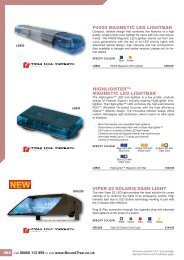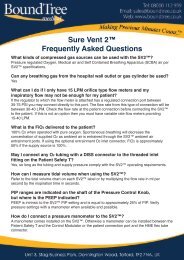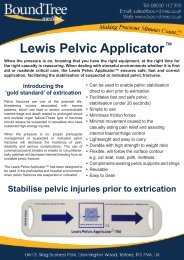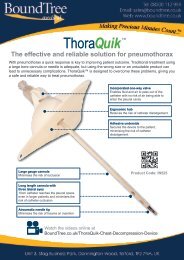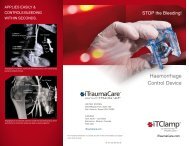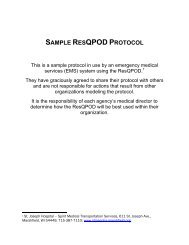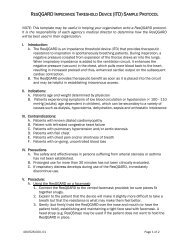Sure Vent 2™ Guidelines for Use - Bound Tree Medical
Sure Vent 2™ Guidelines for Use - Bound Tree Medical
Sure Vent 2™ Guidelines for Use - Bound Tree Medical
You also want an ePaper? Increase the reach of your titles
YUMPU automatically turns print PDFs into web optimized ePapers that Google loves.
<strong>Sure</strong> <strong>Vent</strong> 2<br />
<strong>Guidelines</strong> <strong>for</strong> <strong>Use</strong><br />
PLEASE NOTE: These guidelines <strong>for</strong> use are NOT be used as a training<br />
manual. Please contact us <strong>for</strong> full, detailed instructions or<br />
refer to the <strong>Sure</strong> <strong>Vent</strong> 2 Operations Guide.<br />
1. Connect oxygen tubing to the SV2 with the DISS or barb fitting and then to<br />
the oxygen source.<br />
2. Set an intial flow meter rate of 15LPM.<br />
3. Verify Peak Inspiratory Pressure (PIP) is 25cmH2O or adjust the Pressure<br />
Control know to achieve desired PIP. Note: Indicated pressure on the Pressure<br />
Control Knob is approximately ± 10% and may vary depending upon climatic<br />
conditions. Verify pressure settings with a manometer. PEEP is intrinsic to the<br />
SV2 at 25% or 1/4 of PIP.<br />
4. Connect Patient to the SV2. Effective ventilation with the SV2 is best when<br />
used in conjunction with an endotracheal tube and the use of an ETCO2<br />
monitoring device. When using the SV2 with a mask, ensure the mouth and<br />
airway are clear of visible <strong>for</strong>eign bodies and position the patients head to ensure<br />
the correct position of the airway. Position the mask using accepted techniques<br />
and adjuncts to maintain a clear airway. When using an LMA the PIP should be<br />
restricted to a maximum of 20cmH2O.<br />
5. Adjust the Rate Control Knob <strong>for</strong> desired respiratory rate. The SV2 is factory<br />
pre-set at 12-14 BPM. Calculate the rate manually by counting off 1-1000,<br />
2-1000, etc. or with a timer. Observe chest rise and fall corresponding to<br />
patient’s inhalation and exhalation. Listen to chest sounds as well as expiratory<br />
flow from the modulator.<br />
PAP (positive airway pressure) mode <strong>for</strong> spontaneous breathing patients<br />
may be set by adjusting the Rate Control knob clockwise until automatic cycling<br />
stops and the desired airway pressure is attained (10cmH2O unless otherwise<br />
directed). The patient will then trigger a cycle with each breath. Note: A<br />
minimum flow rate of 15 LPM is required. To return to automatic cycling, turn<br />
Rate Control Knob counter clockwise until automatic cycling resumes and desired<br />
respiratory rate is attained.
If the patient vomits disconnect the patient Safety T from the SV2 control<br />
modulator. Clear any vomitis from the modulator and Safety T by tapping to<br />
dislodge large particles. Clear the mask. Clear patient’s ariway and reconnect.<br />
This procedure can be accomplished in less than 20 seconds. Check rate and<br />
pressure and adjust if necessary. Verify inhalation and exhalation occurs without<br />
obstruction.<br />
IMPORTANT: Changes in a patients lung compliance will result in respiratory<br />
rate changes. Make appropriate adjustments of rate and pressure as necessary.<br />
Monitoring of patient is required at all times. Patient must<br />
not be left unattended. Do not use as an unattended<br />
automatic ventilator. The use of alarms (optional) enhances<br />
monitoring capability.



